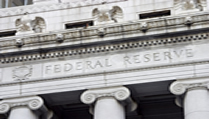Rates might be heading higher sooner than investors think, according to experts in a NeuGroup webinar.
 Despite the seemingly “no end in sight” low-interest-rate environment, rates might be heading higher sooner than you think. This was one of the conclusions of a webinar hosted by the NeuGroup with featured speakers Tim Johnson and Steve Friedman from investment advisor Fischer Francis Trees & Watts (FFTW).
Despite the seemingly “no end in sight” low-interest-rate environment, rates might be heading higher sooner than you think. This was one of the conclusions of a webinar hosted by the NeuGroup with featured speakers Tim Johnson and Steve Friedman from investment advisor Fischer Francis Trees & Watts (FFTW).
FFTW believes that US rate hikes will commence mid-2015, with policy rates expected to be around 3.0 percent by end of 2016. With the US economy accelerating and GDP growth for 2014 expected to be around 2.5 percent, Mr. Friedman said his firm sees an earlier lift-off and steeper path of rate hikes than the market or Fed Open Market Committee (FOMC). This is based on the view that labor market slack is less than commonly thought and household balance sheet repair is further along than thought. Mr. Friedman expects unemployment to drop to 6 percent by the end of 2014. The tightening labor market will eventually prompt wage gains, forcing the Fed to look at wages as a signal that full employment has been achieved.
The Fed has undertaken its taper, reducing the amount of bond purchases it makes, but will also look for other ways to drain liquidity from the market, one of which through the reverse repo market – wherein market participants loan the Fed cash at a fixed rate (vs. the other way around). So the first tightening will occur when they start raising rates in this repo facility begun in late 2013. Still, for this to be a success, the Fed will need careful communication, and perhaps it may even stop referencing fed funds rate. So watch for this as the start of rising rates, Mr. Friedman said.
Stay in short end
Mr. Johnson and Mr. Friedman also discussed the various global economic market conditions, which range from fighting stagnation to managing expansion.
In the US and UK, with declining slack, wage indicators are becoming increasingly important. The Eurozone is returning to growth, but faces rising deflation risk. Meanwhile, Japan has implemented its multi-pronged approach of Abenomics (the Three Arrows). The first arrow, the quantitative and qualitative easing (QQE) by new BOJ Governor Kuroda, has slowed inflation, while the second arrow, flexible fiscal policy appears to be on track and showing results. The third arrow, the growth strategy, has yet to show results and there remain questions about whether it will take flight
These uneven global recovery prospects will drive cross-market divergence:
- The UK and US has accommodative monetary policy backdrop, healthier household balance sheet, improved business confidence, and reduced fiscal drag. All of these bode well for recovery to accelerate.
- Eurozone’s solvency concerns are not fully resolved, credit channels are impaired, and the currency is too strong to support peripheral growth.
- Japan’s QQE can boost inflation and growth in the short terms, but necessary structural reforms to boost productivity can take years.
There are some risks to global growth. First and foremost could be Fed and/or BOE missteps as well as central bank messaging with the market just assuming the wrong thing.
What does this all mean for the Investment Portfolio? Mr. Johnson expects rates of the US 10-year note at the end of the year will be 3 to 3.5 percent, currently 25-50 basis points higher than current forwards indicate. FFTW is advising clients to remain in the short-end of the curve. Mr. Johnson said that macro factors warrant higher yields however, some technical factors have been holding rates back. In the US FFTW is underweight Treasury’s and short duration, and given its positive economic outlook is overweight spread product. For global portfolios FFTW likes Germany, Belgium and the Netherlands, with an underweight to France.
Most market participants know rates are destined to rise again, the big question is when and how this will be accomplished. FFTW certainly makes the case for rates rising sooner than later, or at least sooner than everyone thinks.